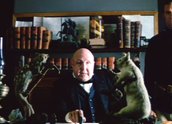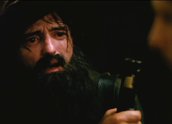


Mad Dog Morgan 1976
Director Philippe Mora comments on 'Mad Dog Morgan’
I had been making the feature documentaries Swastika (1973) and Brother, Can You Spare a Dime (1975) in London and the US when I returned to Australia in 1974 to make Mad Dog (original title). The fact-based book by Margaret Carnegie on which I based the script appealed to me because of its historical accuracy. I wrote the script on a ship voyage from London to Melbourne via Cape Town. A brief stop in apartheid-era Cape Town showed me that the grotesque racism in 1850s Australia was still a virulent force in the world, and convinced me in my own heart I was making something relevant with Mad Dog.
The making of the film was a fantastic experience in the bush, in many of the real locations. The scandalous, outrageous stories surrounding Dennis Hopper and the creation of the film are all mild compared to the actual events. But I took it all in my stride because it was my first ’big’ film and I didn’t know any better, and critically Dennis, in my opinion then and now, was delivering an extraordinary performance of a man in the process of being destroyed by colonial society’s injustices. He made suffering suddenly become flesh, like a Francis Bacon figure in a Sidney Nolan landscape. David Gulpilil was pure magic in front of the camera to my film buff’s eye, and Frank Thring – a long-time favourite of mine – was my perfect incarnation of an antipodean Erich von Stroheim.
The physical shoot was arduous. The grips lugging an arc light up a mountainside looked like a scene from the Second World War. Virtually all of the crew (let’s call it the ‘Class of Mad Dog’) subsequently became legends in their own fields, including John Seale, Brian Bansgrove, Graham Mardell, John Scott and Monte Fieguth. Producer Jeremy Thomas went on to win an Oscar for The Last Emperor (1987). I salute them all. Crews partied hard in those halcyon days, and a line was drawn between those who would drink Old Spice cologne when the beer ran out, and those who would not. For the record, I did not.
One thing I wanted to capture with the same zeal as Thring’s pursuit of Mad Dog, was the science fiction, eye-popping feel of the landscape. These characters from another time were sometimes on another planet. I could not have done that without the fine artistry and skill of DP(Director of Photography) Mike Molloy, fresh from working with photography fanatic Stanley Kubrick. Mike had an arsenal of fantastic optical tricks and, to me, the skies jumped off the screen into your mind. I had long admired Mike, even as a teenager, when he told me scary film stories of shooting newsreel in Vietnam, at my parent’s restaurant, the Balzac.
The finished film immediately polarised audiences in Australia. The nascent film bureaucrats of the day were shocked, even horrified, when they saw the film. It was mentioned to me that Max Fairchild raping Hopper in prison, with Bill Hunter leering, was not their idea of promoting tourism in Australia. My wisecracks that I thought this, in fact, would encourage tourism didn’t help.
They were puzzled, and one apologised to me for previous hostility, when the film got the first US distribution deal for an Australian film at Cannes and opened in 40 cinemas in New York and Los Angeles. The reviews in LA were tremendous (ditto London critics) and I was hired by United Artists to direct a film. This was a breakthrough for myself and Australian directors. Something almost culturally supernatural had happened that year. Four Australian directors – Donald Crombie, Fred Schepisi, Peter Weir and myself – basically unknown to each other, had out of nowhere made four feature films where there was no film industry to speak of. (On our film, cooking a whole sheep was called catering). When those four films – Crombie’s Caddie (1976), Schepisi’s The Devil’s Playground (1976), Weir’s Picnic at Hanging Rock (1975) and Mad Dog – each in their own way hitting an international standard, screened at Cannes as a bloc in 1976, Australian movies had suddenly arrived.
Commentators were scratching their heads as to how this happened. Many still are.
Philippe Mora Writer, Director. July 2008
Disclaimer: Any opinions, advice, statements, views or other information expressed by the creator/s (including in relation to any third-party content they submit to the site) are solely provided by, and the legal responsibility of, the creator/s and not of the National Film and Sound Archive. While the NFSA will monitor the contents of submissions from creator/s, we do not certify, endorse or verify the contents of any communication published on this page. The National Film and Sound Archive reserves the right to remove any comments from this page at its discretion; this reservation creates no affirmative duty in the NFSA, and failure to exercise this power shall not subject the NFSA to any liability of any sort. If you have any concerns about this content please contact online@nfsa.gov.au.
- Overview
- Curator’s notes
- Creator’s comments
- Video 3 clips

- Principal credits
- Find a copy
- Make a comment
- Add your review


